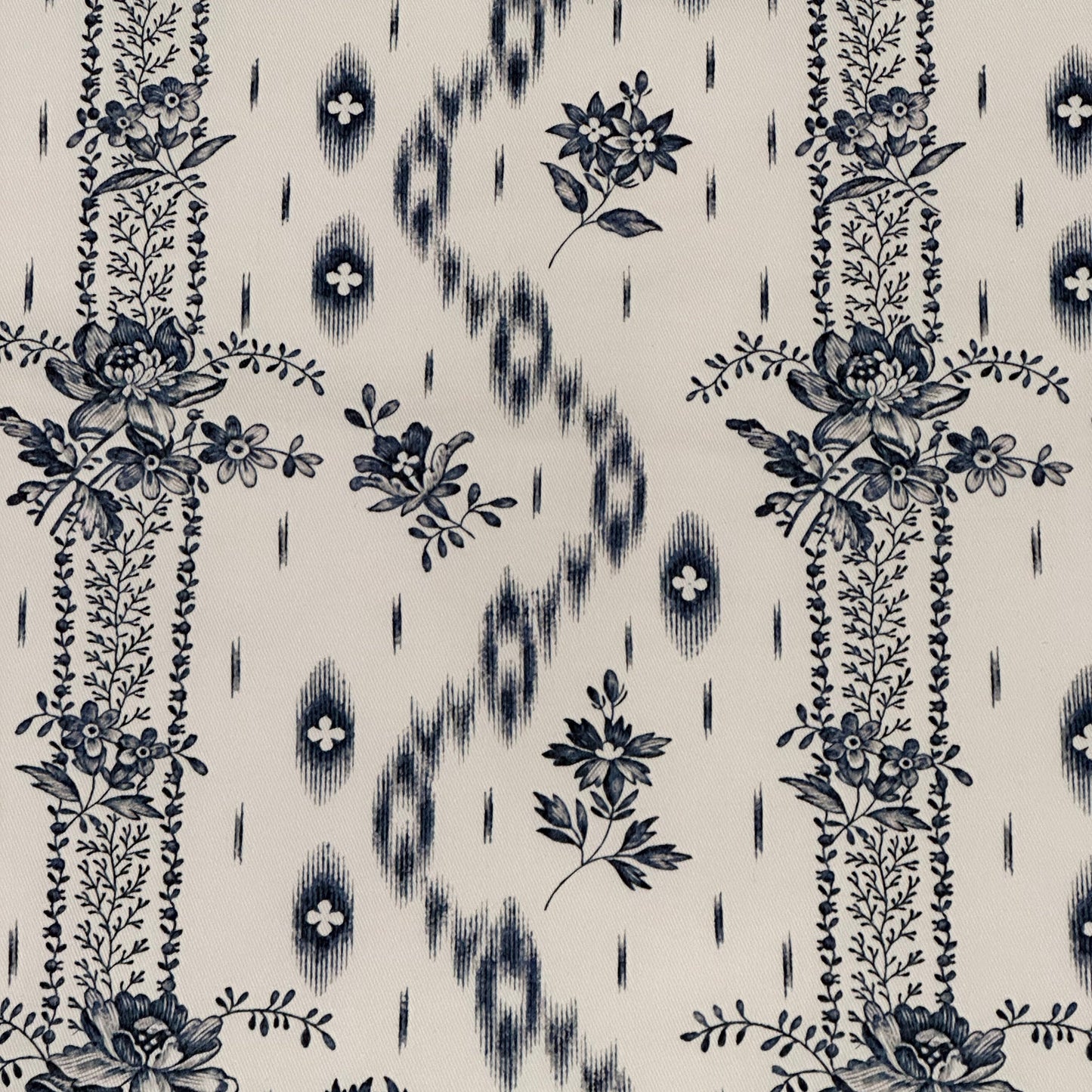1777 Sholberg Peony - Baltic Blue
1777 Sholberg Peony - Baltic Blue
If You have a Company in EU, please send me Your VAT number via email before ordering.
Couldn't load pickup availability
This is Copper plate imitation fabric for Upholstery and I have called this one for Peony. The design can be used for curtains and chairs.
The size of the stripe can be changed between 2 cm and 5 cm, depending on the purpose.
The Whirl Wind Blue is a bit greyish blue colour.
Bromley Hall Copper Plate Printed Textiles
The Bromley Hall Printworks, located in Middlesex, England, was a significant early textile printing manufactory that operated from the 1740s until 1823. Initially established by the Ollive family, who were Quakers involved in calico printing since the late seventeenth century, the factory became well-known for its intricate designs and high-quality textiles. The production of copper plate printed textiles at Bromley Hall is particularly notable for its innovative use of the copperplate printing technique, which allowed for detailed and expansive patterns.
Historical Context and Development
The technique of copperplate printing was developed in Drumconda, Ireland, in the early 1750s and quickly spread to England. English calico printers like those at Bromley Hall excelled in producing large-scale monochrome designs using this method. The factory’s operations transitioned to the Talwin and Foster families between approximately 1763 and 1783, during which time it produced a variety of textile designs characterized by their vibrant colors and complex imagery.
Design Characteristics
The textiles produced at Bromley Hall often featured elaborate motifs that combined European styles with exotic influences. For example, one prominent design included long-tailed pheasants set against a backdrop of bold flowers. This design reflects a blend of European textile aesthetics with elements inspired by Indian palampores and Chinese motifs. Such combinations were indicative of the broader trends in textile design during the eighteenth century when manufacturers drew inspiration from various cultural sources.
Pattern Books and Preservation
A key artifact from this period is a pattern book preserved at the Victoria and Albert Museum in London, which contains 144 copperplate designs dating from around 1760 to 1800. While not all designs are represented in this collection, many share similarities with those produced at Bromley Hall. The patterns often included birds and floral decorations that showcased the factory’s specialty in finely drawn avian motifs.
Legacy and Influence
Bromley Hall’s influence on textile design extended beyond its operational years; it contributed significantly to the evolution of printed textiles in England. The combination of artistic inspiration from various cultures along with technical advancements made by English printers positioned Bromley Hall as a leader in the industry during its time.
In summary,
The Order lead time
The Order lead time
The Order lead time (OLT):
Order Lead Time means the minimum amount of time between the date of order and the date for the delivery of the product to the shipping location designated by customer. Due the MTO, the normal OLT is between approx. 21 working days from payment to product.
The buttle neck in this process is the shipping time.
(MTO - Make to order)
Sustainable Development
Sustainable Development
The importance of global sustainability awakens with Agenda 2030 goals in mind.
Agenda 2023 refers to a set of initiatives and goals aimed at addressing global challenges and promoting sustainable development. While there is no single, universally recognized “Agenda 2023,” it often relates to the ongoing efforts stemming from the United Nations’ Sustainable Development Goals (SDGs) established in 2015 under the broader framework of the 2030 Agenda for Sustainable Development. This agenda emphasizes the need for collaborative action among nations to tackle issues such as poverty, inequality, climate change, and environmental degradation.
We use only high quality cotton or silk from authorised producers and we produce only by demand. There is no overstocks of any fabrics with negative environmental impact. For our customers, purchase with clear conscience from us.
Read more about the 2030 goals here
Dimensions
Dimensions
The Fabrics are sold per meter or multiple of meter.
1 meter - 1,09 YRDs
Please see the fabric types on main menu for full Fabric info.
The width of the fabrics:
- Cotton Satin :156 cm
- Cotton Voile 140 cm
- Cotton Cretonne: 147 cm
- Cotton Poplin: 140 cm
- Cotton Linen 137cm
- Cotton Panama 147 cm
- Cotton Gabardine 147 cm
- Cotton Mul Mul 125 cm
- Silk Chiffon 140 cm
- Silk Dupion 140 cm
- Silk Satin 140 cm
Care Instructions
Care Instructions
Grandma's Laundry Tricks:
- Do not Brush, Rub or Scrub the printed fabrics too hard to avoid damage to print quality.
- Wash with similar colours to avoid staining or tint.
- Please do not overuse the centrifuge, it only wrinkles the fabric.
- Please do not overuse the dryer or use extrem heat, this only tears the fibres apart.
- A dehumidifier is a great invention to dry the fabrics and clothes.
- Dry the fabrics outdoors, if possible, but not under direct sunlight.
- Environmentally awareness and the durability of clothing go hand in hand.
- Do You really need to use the fabric softener or is white vinegar good enough?
Share






